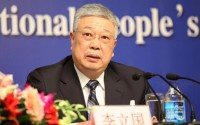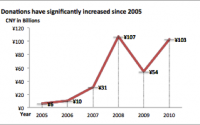A Snapshot of American NGOs in China
Earlier this year, China Charity and Donation Information Center (CCDIC ) released Report of the Philanthropy Study on International NGOs (USA Section) in China. Although reports on individual organizations and cases are seen in media, this paper is the first attempt to take a systematic view of the landscape and impact of international philanthropic organizations in China. It is estimated that around 1,000 American nonprofit organizations work in China, but this paper is based on a sample of 266 American organizations engaged in the social sector. [ Some of you may have already known that philanthropy and nonprofit organizations are not distinguished in China, so American NGOs in this paper also include foundations. ]
As data collection in Chinese social sector is relatively a new practice, it’s understandably challenging for CCDIC to take a quantitative analysis approach, especially for historical review. I’ll take a few excerpts from the report to give you a rough idea on the landscape of American charity organizations in China. Please do keep in mind, all the percentage is based on the sample pool of 266 organizations.
1. Types of organizations:
2. Areas of charity activities
American NGOs are mostly engaged in 7 areas:
- Human services: e.g. Brother’s Brother Foundation, Mercy Corp, Doctors without Boarders
- Women’s rights and benefits: e.g. Winrock International, Global Fund for Women, Bill & Melinda Gates Foundation
- Labor rights: e.g. Fair Labor Association, International Labor Rights Forum, Asia Foundation
- Environment/Animals: e.g. The Nature Conservancy, Environment Defense Fund
- International relations and policy research: e.g. Committee on Scholarly Communication with China, National Committee on United States China Relations
- Industrial and commercial associations: e.g. The US-China Business Council, The American Chamber of Commerce
- Others: e.g. American Bar Association, Volunteers in Asia
[space]3. Type of grantmaking recipients in China
Most public charities operate their own projects in China, so funding comes mostly from independent foundations and corporate foundations. Higher education, government agencies and research institutes have received over 80% of the total funding. It’s also worth noting that many of the research institutes may have government ties.
In China, there used to be an argument that many grassroots organizations were brought up with “foreign milk” (foreign funding ). The numbers above seem to have dispelled such statement.
4. Status of registration
94 organizations in the sample of 266 NGOs have ongoing operations in China. Among the 94 organizations, only 23 organizations were registered with Ministry of Civil Affairs or its regional branches, which means roughly 20% of the organizations have a legal status as an NGO in China. About 40% were registered as a business, and the rest either didn’t register at all or their status is not clear.
American NGOs’ failure to register as a legitimate NGO in China is mostly due to the strict restrictions on registration, which is also true with Chinese NGOs. However, some people pointed out although international NGOs may encounter legal barriers on registration, they are often welcomed by the government in their operation. On a related note, Overseas NGOs are not allowed to do fundraising in China.
5. Impact of American NGOs
The report describes positive impact of American NGOs on China in four aspects:
- Political and legal: facilitating and sponsoring talent development for government officials and thought leaders, providing policy consultancy, and researching and promoting human rights and democracy. Ford Foundation, Asian Foundation, The Carter Center are the major examples.
- Economic: encouraging international exchange and cooperation, supporting talent development in economic field etc.
- Educational: providing learning and training opportunities to Chinese talents in various fields, strengthening capacity in higher education, and directly supporting education for underprivileged group
- Philanthropic and nonprofit: directly participating in all kinds of human service and disaster relief projects, helping build the capacity of Chinese NGOs, introducing new concept to China, such as civil society, volunteering, corporate social responsibility, etc.
[space]Reference:
- Report of the Philanthropy Study on International NGOs (USA Section) in China ( PDF, Chinese )
- Liu YouPing on Status and Impact of American NGOs in China ( Article, Chinese )
[space]
[space]





